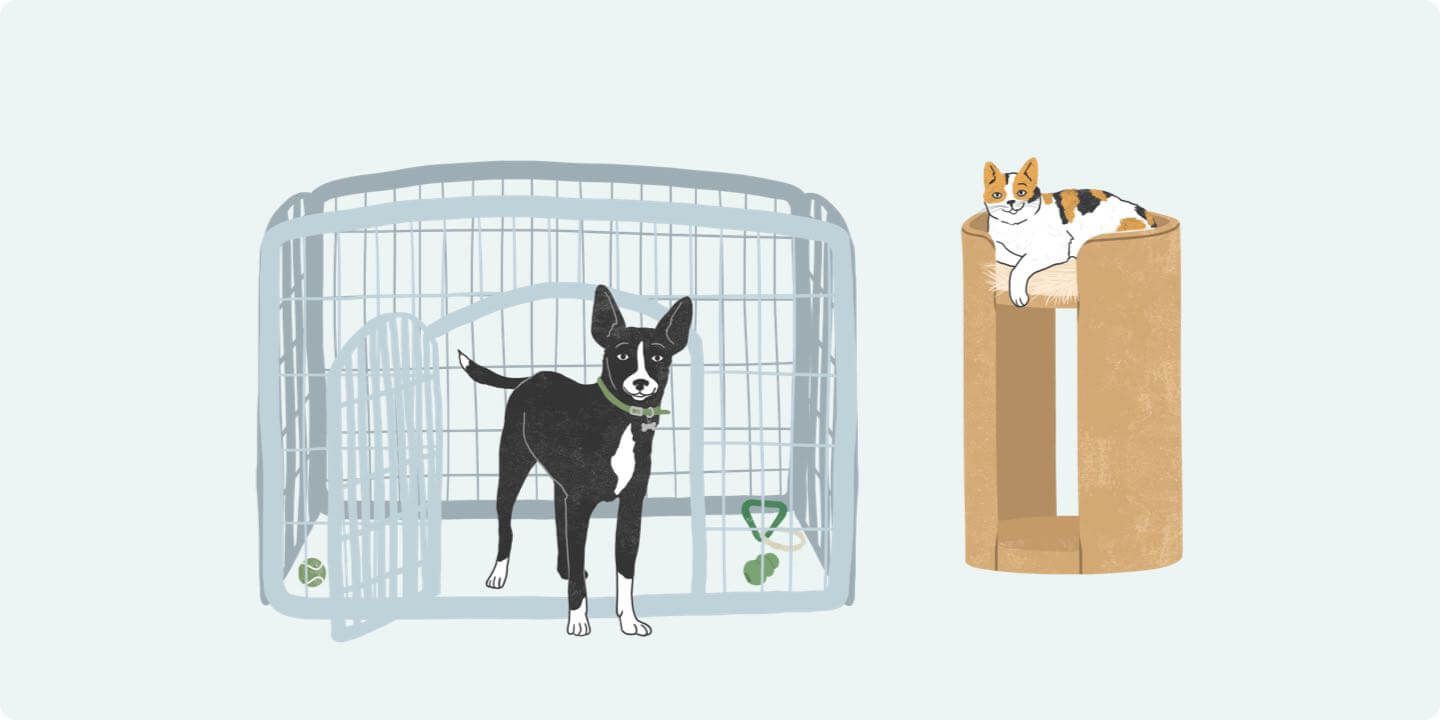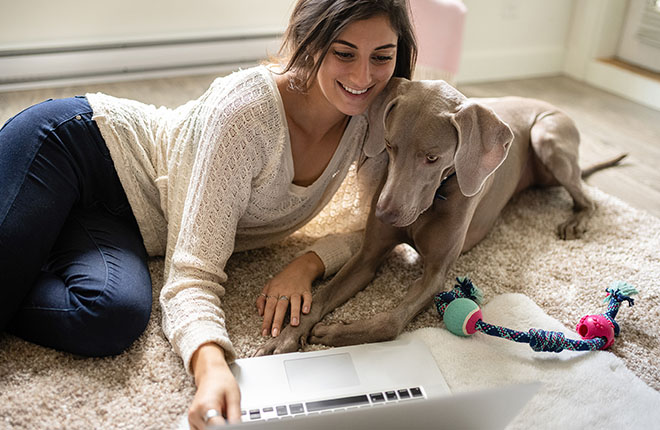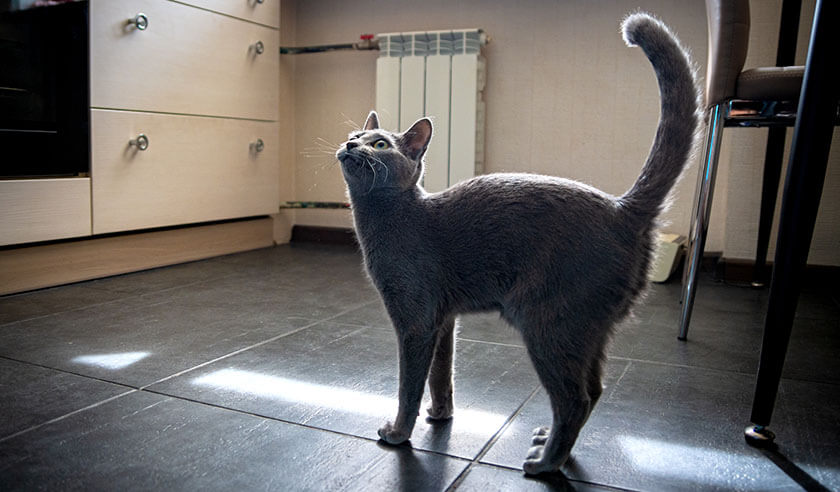There are many situations where you could have been home from work with your dog or cat for an extended period of time. During this time, your pet likely grew accustomed to having someone at home with them. You might have adopted a new dog or cat recently with a history of separation anxiety (or you aren’t sure how they’ll do when left alone). Whatever your pet’s situation, there are steps you can take in order to reduce the likelihood of separation anxiety and minimize their stress.
How to Tell If Your Pet Has Separation Anxiety or Is Stressed
Some pets might show minimal signs of stress during a time of change, while others suffer from more severe stress, or even separation anxiety. Watch your pet’s body language for signs they are anxious. You might see these signs throughout the day when you are present, or these signs might become more noticeable as you get ready to leave. Setting up a camera to check in on your pet while you’re gone can also help you determine their stress and anxiety levels.
Signs of Dog Separation Anxiety and Stress:
- Pacing
- Panting
- Yawning
- Shaking or trembling
- Hiding
- Barking and howling when alone
- Clingy behavior or constantly shadowing you as you prepare to leave
- Excessive drooling
- Destructive chewing or scratching when alone
- Potty accidents when left alone (even though they are reliably housetrained when with owner)
- Attempts to escape their crate, pen, or out a door or window if not confined when alone
Signs of Cat Separation Anxiety and Stress:
- House soiling or spraying
- Change in eating or sleeping habits
- Hiding
- Aggressive behavior
- Excessive grooming and licking themselves
- More vocalization than normal
- Destructive scratching

If your cat or dog shows these signs as you’re preparing to leave or while you’re gone, explore separation anxiety treatment with your veterinarian and begin a behavior modification program.
Why is Your Pet Showing Signs of Separation Anxiety?
If your dog or cat does develop separation anxiety, it’s important to realize that they’re not acting out of spite or because they’re bored. They’re acting out of fear and anxiety and are truly distressed. We don’t know why some pets experience separation anxiety and others don’t, but some factors can predispose pets to this condition.
- Pets that have spent time in a shelter and have been re-homed multiple times
- Puppies that have not been properly socialized
- A sudden change in the household, such an owner who has stayed at home for some time then starts a job that takes them out of the house
- Being trapped alone during a traumatic event such as an earthquake or hurricane
Additionally, if your dog is especially clingy, follows you everywhere, or needs to always be by your side, they may also be more likely to develop separation anxiety when you go back to the office.
Never punish your pet for separation anxiety, remember they are acting out of fear and anxiety and punishing them will only make them more fearful and anxious.
Slowly Transition Back to Your Regular Routine
Having a consistent routine and structure helps your pet feel secure. If you’re anticipating a change in routine, it’s best to slowly acclimate your dog or cat to the new schedule in small increments. If possible, start incorporating new parts of your upcoming routine as early as a month in advance.
- Begin Waking Up Earlier
Mornings often tend to be more relaxed and less hurried when you don’t have to get the kids to school or drive into the office. Start to set your alarm earlier each day until you’re waking up at what will be your new normal time. - Plan Out Your Morning and Evening Routine With Your Pet
Feed your pet their breakfast and dinner at the same time each day. Take your dog for their usual walks and play or cuddle with your cat as you plan on doing during your new routine. Maintain a consistent potty schedule as well.
Keep Life as Normal as Possible
Pets can experience something called “emotional contagion”, meaning they internalize anxious signals from their owners. Therefore, it’s important to not exhibit signs of stress in front of your pet and try to keep life as normal as possible.

Set up a Safe Place for Your Pet
Set up an area where your dog or cat feels safe, calm, and relaxed. Many dog owners will crate train their dog or set up a playpen for them to stay in while alone. Introducing these areas well in advance of your first day out of the house can help your pet relax and enjoy their time in their own “room” while you’re gone. Cat owners can provide a cat tree with areas to hide out in or set up a comfortable cat bed near a window for their cat to sit and watch nature.
Encourage your pet to settle in their safe place while you’re home. You can practice leaving them there with an interactive toy or chew while you work in the other room with the door closed. Feed your pet their regular meals in this area to continue to build positive feelings with being in their space.
Give Your Pet Plenty of Exercise
Physical and mental exercise goes a long way in reducing stress for our pets. Beyond giving your pet important physical exercise, playing with your dog or cat also reduces stress (for both you and your pet). For senior pets who might not be able to physically exercise as much as they used to, provide them with lots of mental enrichment activities, such as food puzzles or short clicker training sessions throughout the day.
Practice Leaving Your Pet Alone
Weeks before you return to the office, start teaching your pet that being left alone is no big deal. Give them an interactive treat toy as part of what will be your “leaving for work or school” routine.
The goal is for your pet to acclimate to being alone - this is called desensitization.
When you first start practicing leaving your pet alone, start small! This might be only a quick trip to the mailbox the first few times. Try not to make a big production of your leaving or returning — stay calm and low-key. The goal is for your pet to gradually to being alone — this is called desensitization. If your dog or cat is not showing signs of stress while alone, you can increase the length of time you’re gone.
When You Return to Work
On the day that you finally do go back to work, minimize some of the triggers that might tip off your pet that you’re going to leave.
- Place your keys in your coat pocket and pack your bag or backpack the evening before.
- Use a distraction technique with a food puzzle or toy, then quietly leave while they’re enjoying their treat.
- By pairing a treat puzzle or other positive experiences to your leaving the home, the dog can start to associate you leaving with something good. This is call counter conditioning and combined with the desensitization exercises can be an effective way to train your dog to be calm when left alone.
- When you return home, your pet will likely be overly happy to see you. Resist the temptation to give them a vigorous pat until they settle down. Calmly take off your coat or read your mail until your pet settles down, then calmly greet them. Don’t be overly enthusiastic when you do greet your pet. You want to keep them from having big swings of high and low emotions associated with you being home or leaving for work.
Other Options for Daytime Pet Care
If you’re noticing that your dog is struggling with being left alone, consider whether they would do well in dog daycare. If daycare isn’t right for your dog, having a dog walker come by in the middle of the day can help relieve your dog’s stress and give them a chance to exercise. Alternatively, you can see if you can leave your dog with a friend or relative during the day. Hiring a dog walker can be especially helpful if your dog has grown accustomed to midday walks while you’ve been working from home. If your office is dog-friendly, consider whether your dog will do well in an office setting. Cat owners can have a pet sitter visit midday to check on their cat and provide a play session to help them relieve stress.
If you notice that your dog or cat is having a difficult time adjusting to the new schedule (even during your trial sessions) talk with your veterinarian for treatment options. It’s important to address your pet's separation anxiety early to both relieve their suffering and keep the signs from progressing.
ZPC-00811R2



.jpg)

